Release Date :
Reference Number :
2022-018
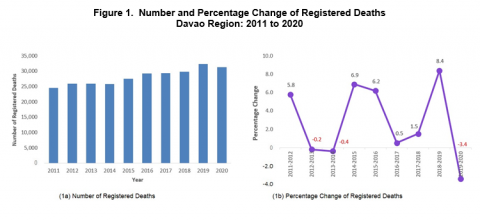 An average of 85 deaths daily in Davao Region
An average of 85 deaths daily in Davao RegionIn 2020, a total of 31,270 deaths were reported in Davao Region as their usual residence, a decline of 3.4 percent from 32,384 in 2019. This is equivalent to a crude death rate1 of 5.9, or about six deaths per 1,000 population in 2020. This corresponds to an average of 85 deaths per day, which translates to 4 deaths per hour.
The number of registered deaths in Davao Region from 2011 to 2020 showed an increasing trend except in the years 2013, 2014 and 2020. The increase during the ten-year period was 27.4 percent, from 24,537 in 2011 to 31,270 in 2020. (Figure 1 and Table 1)
Highest number of deaths reported in City of Davao
The highest number of registered deaths by usual residence occurred in City of Davao with 10,917 (34.9%), followed by Davao del Norte with 6,945 (22.2%), and Davao de Oro with 4,432 (14.2%). The combined share of these two provinces and Highly Urbanized City was 71.3 percent of the total registered deaths in the region.
On the other hand, Davao Occidental had the least number of deaths with 1,232 (3.9%). (Figure 2 and Table 2)
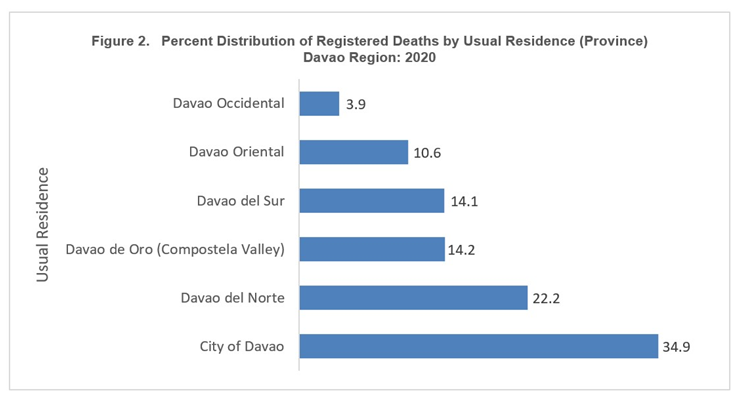
December 2020 had the mostnumber of deaths
The number of deaths reported in Davao Region as the place of occurrence in 2020 was 32,255. In terms of daily average, December recorded the highest average deaths with 104 or about 4 deaths per hour. The month of May had the lowest number of deaths registered per day at 73. (Figure 3 and Table 3)
Registration of the 703 deaths were done in 2021.
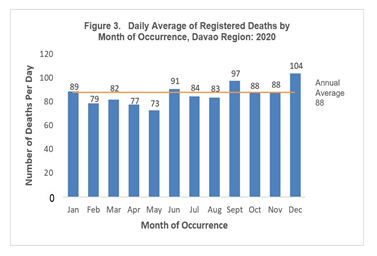
Daily index refers to the increase/decrease from the overall daily average of event occurrences. The months of February to May, July and August fall below the regional daily index of 100.0 in 2020. In other words, daily average deaths in these months were lower than the regional daily average of 88 deaths. (Figure 3 and Table 3)
More male deaths than female deaths recorded
Figure 4 shows the age-sex structure of registered deaths in 2020 in Davao Region. It shows an inverted pyramid, with fewer deaths at the younger ages, except for children under one, and progressively increasing as people grow older. The number of male deaths (18,468) was higher than female deaths (12,802). The proportion of males who died was highest at the age of 65 to 69 years old (2,179 or 11.8% of male deaths) while for females, the largest was at the oldest age group, 85 years old and over (1,617 or 12.6% of female deaths). (Figure 4 and Table 4)
The sex ratio of 144 indicates that there were about 144 male deaths for every 100 female deaths. Moreover, sex ratio of over a hundred means that there were more male deaths compared to their female counterparts at each age group before 80 years old. Higher proportions of female deaths were observed in the older age groups (80 years old and over) compared to its male counterparts. (Figure 4 and Table 4)
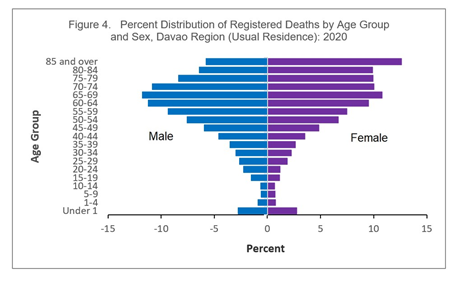
Two out of five deaths were attended by health care provider
Attendant refers to a private physician, public health officer, hospital authority, or any other allied health care provider who provided medical attendance to the deceased.
Out of 31,270 registered deaths (usual residence), 38.5 percent or 12,034 deaths were medically attended. Four provinces namely: Davao Occidental (53.2%), Davao Oriental (57.3%), Davao de Oro (61.0%) and Davao del Norte (61.7)% had more unattended than attended deaths. (Figure 5 and Table 5).
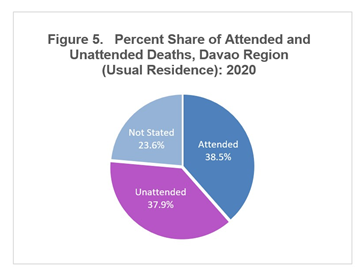
Over half of the total registered deaths occurred at home
In 2020, 16,742 or 51.9 percent of the total deaths occurred at home while 14,034 or 43.5 percent died in health facilities. Some (4.6%) died in places other than home and health facilities, such as on the street, in public places, on board a vehicle, or vessel while in transit, among others.
Among the five provinces and Highly Urbanized City, only Davao del Norte and City of Davao had more deaths that occurred in hospital facilities than any other site of occurrence at 54.5 percent and 54.3 percent, respectively. (Figure 6 and Table 6)
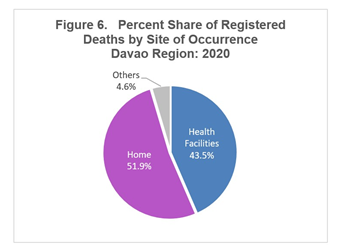
Highest number of infant deaths recorded in City of Davao
Infant deaths are deaths that occurred before reaching age 1. At the regional level, 871 infant deaths were registered in 2020. Three out of five deaths were males (512 or 58.8%).
City of Davao recorded the highest number of infant deaths (319 or 36.6%) followed by Davao del Norte (221 or 25.4%). On the other hand, Davao Occidental had the least number of registered infant deaths at 25 or 2.9 percent. (Figure 7 and Table 7)
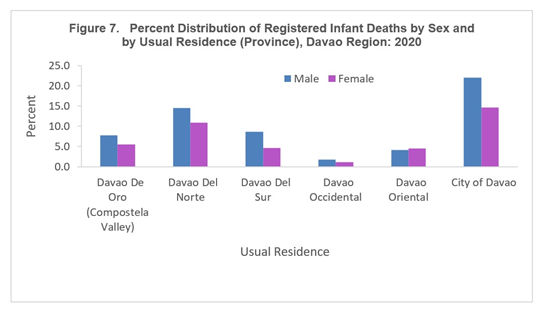
Highest number of maternal deaths recorded in City of Davao
A maternal death is defined by the World Health Organization as “the death of a woman while pregnant or within 42 days of termination of pregnancy, irrespective of the duration and the site of the pregnancy, from any cause related to or aggravated by the pregnancy or its management, but not from accidental or incidental causes.” In 2020, a total of 91 women in the region were identified to have died of maternal causes.

Among the provinces and HUC, City of Davao recorded the highest number of maternal deaths with 27 (29.7%), followed by Davao del Norte with 23 (25.3%), and Davao Oriental with 15 (16.5%). On the other hand, Davao Occidental (3 or 3.3%) recorded the least number of maternal deaths. (Figure 8 and Table 8)
Ischaemic heart diseases led causes of deaths
Deaths due to ischaemic heart diseases were the biggest contributors among the total deaths in 2020 in Davao Region, making up 12.9 percent (4,024) of the total registered deaths. This was followed by deaths due to cerebrovascular diseases (including stroke) at 12.6 percent (3,948) and neoplasms, also known as “cancer” at 10.1 percent (3,164). Mortality due to Diabetes Mellitus also ranked among the leading causes of deaths with 1,923 or 6.1 percent of the total registered deaths. By sex, similar trend with some deviations in the ranking among the leading causes of deaths was observed. (Figure 9 and Table 9)
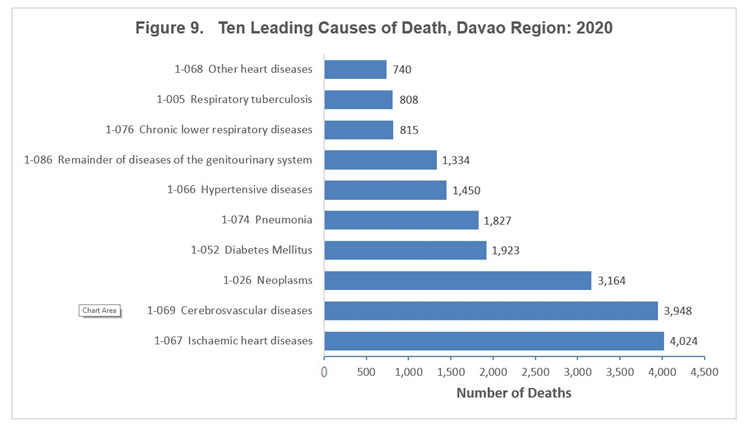
RUBEN D. ABARO, JR., CESE
Regional Director
Regional Statistical Services Office – Davao Region
Attachments:
Table 1. Number and Percentage Change of Registered Deaths, Davao Region (Usual Place of Residence): 2011-2020
Table 2. Number and Percent Share of Registered Deaths by Sex and by Usual Residence (Province), Davao Region: 2020
Table 3. Number and Percent Share of Registered Deaths, Daily Average and Daily Index, by Month, Davao Region (Place of Occurrence): 2020
Table 4. Number and Percent Share of Registered Deaths by Sex, Sex Ratio and Age Group, Davao Region (Usual Place of Residence): 2020
Table 5. Number and Percent Share of Registered Deaths by Attendant and Usual Residence (Province), Davao Region: 2020
Table 6. Number and Percent Share of Registered Deaths by Site and Place of Occurrence (Province), Davao Region: 2020
Table 7. Number and Percent Share of Registered Infant Deaths by Sex and Usual Residence (Province), Davao Region: 2020
Table 8. Number and Percent Share of Maternal Deaths by Usual Residence (Province), Davao Region: 2020
Table 9. Ten Leading Causes of Death by Sex, Davao Region (Usual Residence): 2020

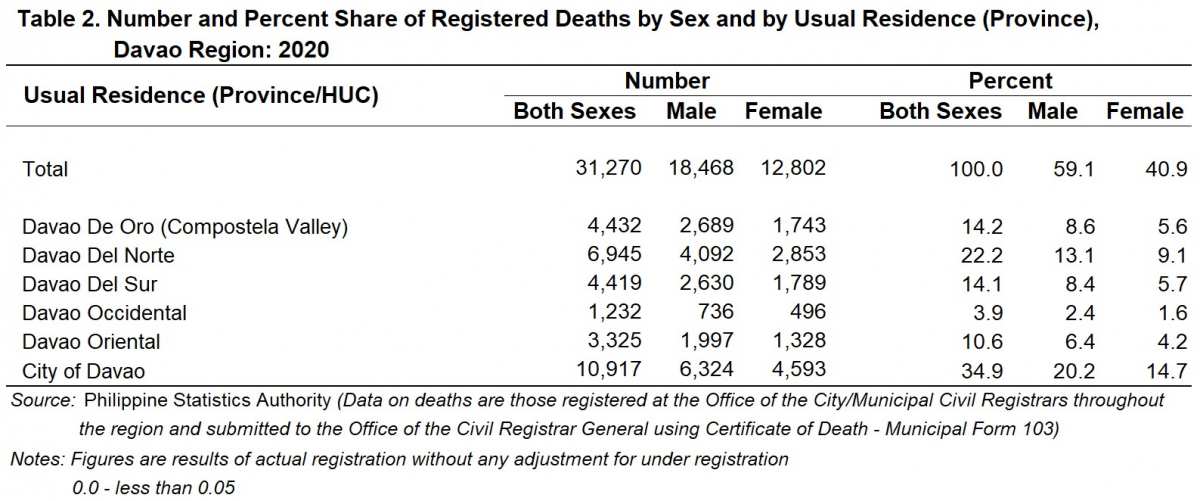

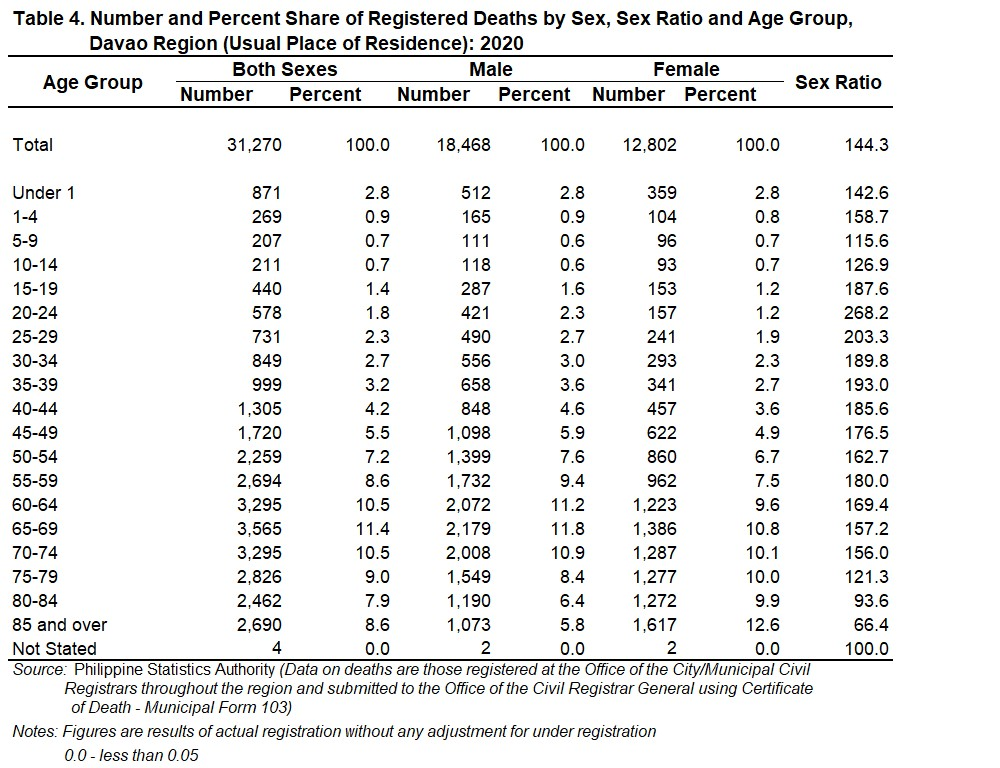
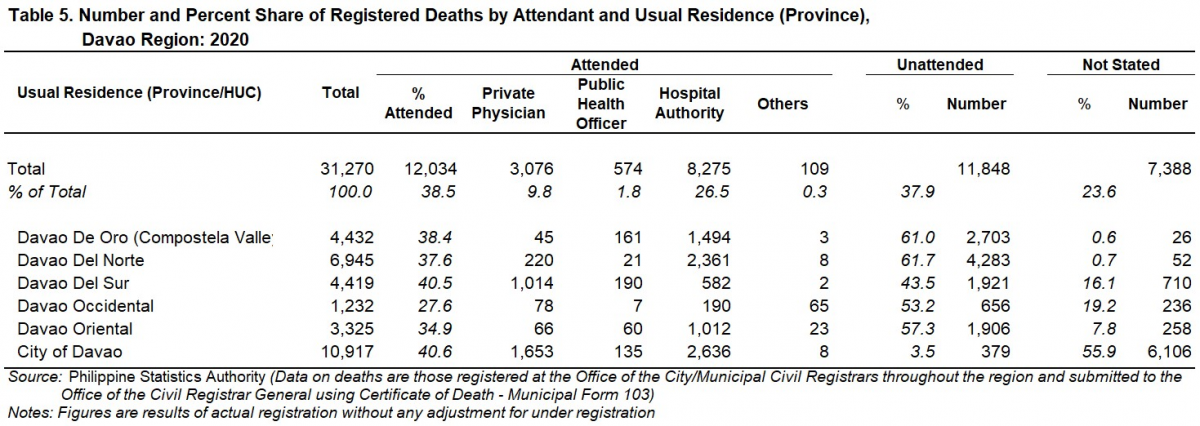
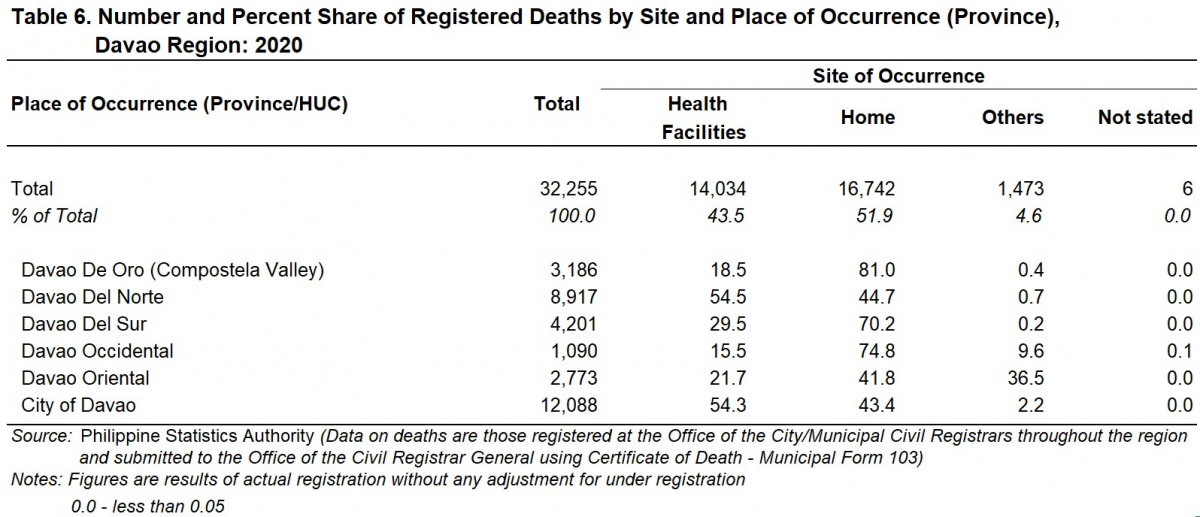

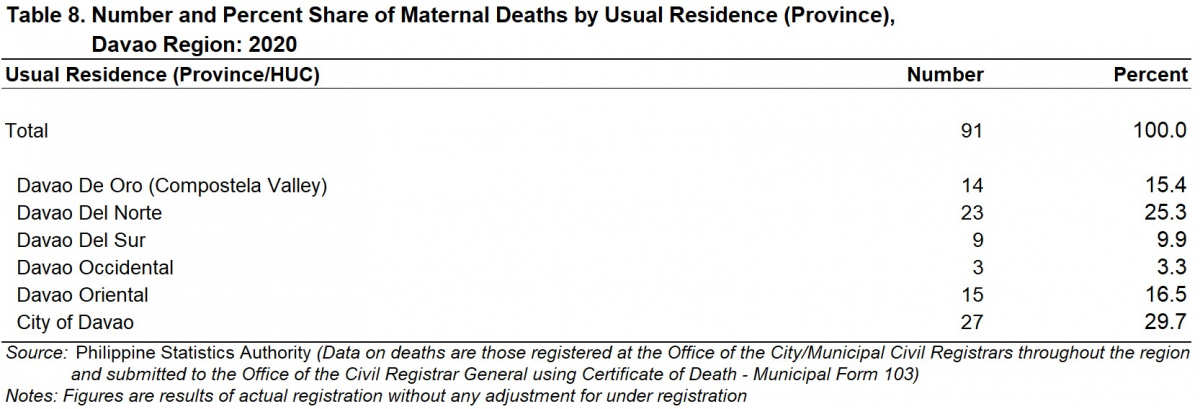
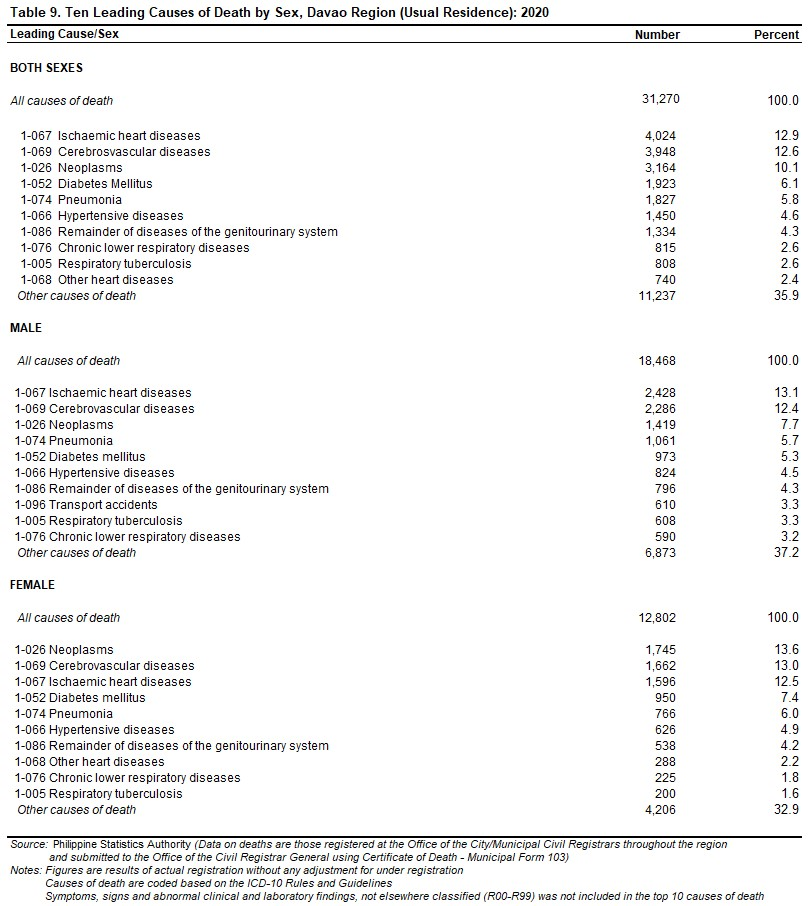
Explanatory Notes
Data on deaths presented in this release were obtained from the Certificates of Death (Municipal Form No. 103) that were registered at the Office of the City/Municipal Civil Registrars all throughout the region and forwarded to the Philippine Statistics Authority. This release shows an overview of the registered deaths which occurred from January to December 2020, including the 10 leading causes of death. Cumulative figures for 2020 reflect updated data which excludes fetal deaths present in the processing of regular deaths and may differ from preliminary counts previously published. Figures shown were not adjusted for under registration.
